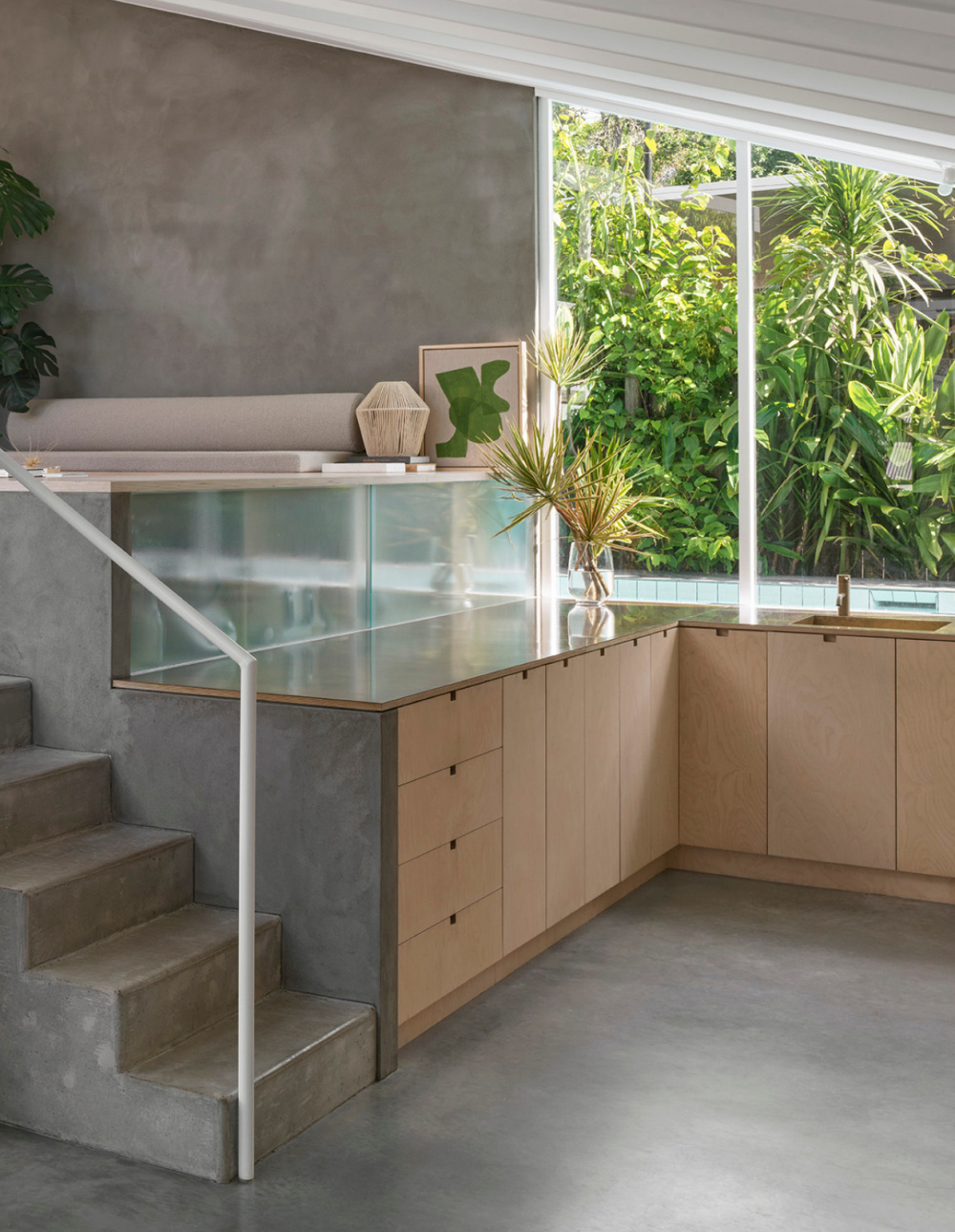Architecture

A relatively compact 65 square metre addition by John Ellway Architect has effectively transformed Cascade House — a circa 1900 Queenslander home in Paddington, Brisbane. Photography – Toby Scott

Artwork by Jacqueline Kaytar for Repose. Rather than raising the addition to meet the height of the original cottage, John introduced split levels inspired by the 1969 Fern Tree House in Hobart by McGlashan and Everist to mediate the site’s sloping topography. Photography – Toby Scott

Above the footpath level (where bikes, prams and cars park) is the new entryway opening to the dining area and courtyard level. Screened doors slide away into the garden, creating an uninterrupted connection to the lush north-facing area. Photography – Toby Scott

Artwork by Jacqueline Kaytar for Repose. The kitchen sits at the end of this level, with a window to the south overlooking the new pool where children can swim in sight. Photography – Toby Scott

At the peak of the addition is the living area offering views out to the central courtyard and street; down to the meals and pool area; and across to the verandah and bedrooms in the cottage. Artwork by Jacqueline Kaytar for Repose. Photography – Toby Scott

The pool’s waterline sits just below the kitchen benchtop to appear as a continuation of the space, and reflect late afternoon sun onto the raked ceiling above. Photography – Toby Scott

‘I think this project shows the effect that breaking up movement through a house into a series of split levels can have,’ says architect John Ellway of the floor plan. ‘With one simple idea, it deals with the steepness of the site; creates useful spaces to pause, play and rest; and most importantly manages privacy. Artwork in left image by Jacqueline Kaytar for Repose. Photography – Toby Scott

Artwork by Dominique Corti, Paris. The area of that external space feels a part of the adjacent room,’ says John. ‘As well as being beautiful, gardens are fantastic as they are relatively low-cost spaces.’ Photography – Toby Scott

Artwork by Renzi Vorsa. The laundry sits in the original house with the four bedrooms, playroom, and two bathrooms. Photography – Toby Scott

Owner Jacqueline Kaytar’s styling has enhanced the home’s feel to suit the cooler months and evenings. ‘Rather than using doors, in some of the areas I used full length undyed linen sheers,’ she says. ‘They look lovely in the breeze and offer softness to counterbalance the architectural lines.’ Photography – Toby Scott

Bedrooms in the original cottage can be left messy and out of sight from the new living areas. Photography – Toby Scott

Everyday’s a holiday in this bathroom. Photography – Toby Scott

The extension sits to the right of the main home to make the most of the square block. Photography – Toby Scott
A relatively compact 65 square metre addition by John Ellway Architect has effectively transformed Cascade House — a circa 1900 Queenslander home in Paddington, Brisbane.
Prior to the recent updates, the block consisted of the original house with a small lean-to, and a carport four metres below on the sloping, square site.
John Ellway with Hannah Waring designed a new extension to replace these latter structures catering to the owner, Jacqueline Kaytar, founder and creative director at Repose; and her husband, Oscar Nicholson, founder and innovation director at Romeo; with children Ines (8), Anya (5), and Rocco (2).
‘I knew I wanted quality over quantity — something unique to our taste, our Queenslander style home, and the subtropical climate,’ says Jacqueline. ‘I wanted to be able to throw a blanket out and have meals on the lawn, and floor-to-ceiling doors and windows so the home was full of fresh air and sunshine.’
The genius of the new addition lies in its layout and strategically positioned outdoor spaces. Rather than raising the addition to meet the height of the original cottage, John introduced split levels inspired by the 1969 Fern Tree House in Hobart by McGlashan and Everist to mediate the site’s sloping topography.
Above the footpath level (where bikes, prams and cars park) is the new entryway opening to the dining area and courtyard level. Screened doors slide away into the garden, creating an uninterrupted connection to the lush north-facing area. ‘In doing so, the area of that external space feels a part of the adjacent room,’ says John. ‘As well as being beautiful, gardens are fantastic as they are relatively low-cost spaces.’
The kitchen sits at the end of this level, with a window to the south overlooking the new pool where children can swim in sight. ‘The nature of the square block meant that we only had about three metres from the rear of the house to the back fence – a funny space to make useful!’ John says. A long rectangular pool was the perfect solution.
The pool’s waterline sits just below the kitchen benchtop to appear as a continuation of the space and reflect late afternoon sun onto the raked ceiling above.
At the peak of the addition is the living area offering views out to the central courtyard and street; down to the meals area; and across to the verandah and bedrooms in the cottage. Changes in level manage privacy, so bedrooms in the original cottage can be left messy and out of sight.
‘I think this project shows the effect that breaking up movement through a house into a series of split levels can have,’ says John of the floor plan. ‘With one simple idea, it deals with the steepness of the site; creates useful spaces to pause, play and rest; and most importantly manages privacy.
‘At each movement up the small set of steps, visitors tend to stop before being invited to move further into the house.’
Working with garden designer Tom Collins and Briggs & Co Landscaping was critical to defining the existing house and addition, allowing the original cottage to sit proudly as it has for over 120 years. The only alterations to this structure were new electrical and plumbing services. ‘Partly to manage budget, and partly because its hardwood fabric was perfectly okay,’ says John.
Jacqueline was heavily involved in the design of the new interiors, pushing John out of his comfort zone to experiment with different techniques. He says, ‘Jac came to me with an amazing knowledge of materials from her design background and a strong idea about the aesthetic she wanted to work towards creating together.’
Raw brass on the benchtops, handles, and tapware combine beautifully with raw finish birch plywood joinery and John’s signature concrete rendered walls. ‘The contrast of textures and how the tactility makes you feel is what I was thinking about. I wanted my home to be comfortable, robust and appeal to the senses — not just look good in pictures,’ says Jacqueline.
Her styling has also enhanced the home to suit the cooler months and evenings. ‘Rather than using doors, in some of the areas I used full length undyed linen sheers,’ she says. ‘They look lovely in the breeze and offer softness to counterbalance the architectural lines.’
Casual and bright during the day, the house becomes a cosy sanctuary at night when tactile lampshades are softly illuminated. ‘I wanted warm, flattering light in the evenings and woven lampshades from paper cord and raffia, which later became Repose products,’ Jacqueline says. The dappled light they offer against the smooth concrete rendered walls is so lovely.’
Jacqueline says the completed project has ‘totally changed’ how her family interacts, works, and plays. ‘There is the physical spatial aspect that has improved my life, but there is also something more,’ she says. ‘It’s a sense of place that truly reflects me as a person and supports me on a physical, emotional, and spiritual level. It inspires me to create, to connect, to share and to grow.’
John’s attention to detail, dedication, and creativity have provided Jacqueline and her family with the Brisbane home of their dreams. ‘Without a doubt, the best decision we made was using John. I could not have achieved anything close to what we have without him.’



